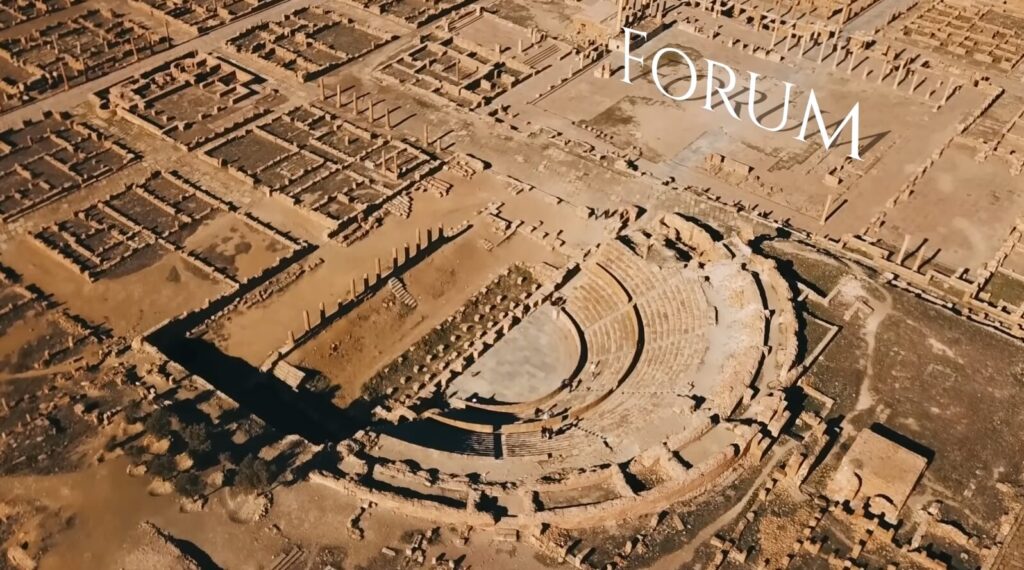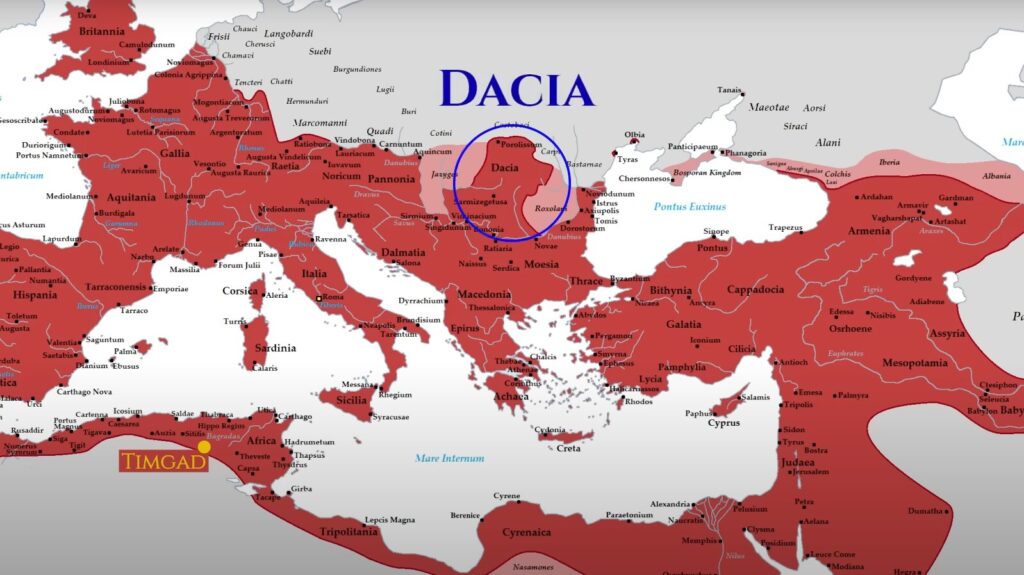Timgad, located on the edge of the Sahara in modern Algeria, stands as one of the best-preserved examples of a Roman colony. Built during the reign of Emperor Trajan around 100 AD, the city followed a strict grid plan that reflected Rome’s approach to urban design. Its streets, gates, forum, and public spaces reveal how Roman planning shaped daily life in frontier settlements.
The colony was established as a reward for military veterans, offering them land, citizenship, and a structured community after years of service. Timgad included temples, baths, a theater, and even a library, showing that Roman culture and religion were central to its identity. Over time, it became both a home for retired soldiers and a symbol of Rome’s presence in North Africa.
Key Takeaways
- The city shows how Rome planned and built colonies in new regions.
- Veterans gained land, homes, and citizenship as rewards for service.
- Timgad reflects Roman culture, religion, and lasting influence.
History and Purpose of Timgad
Establishment Under Trajan
Timgad was created in 100 AD by Emperor Trajan, a ruler known for expanding Roman control to its widest reach. The city followed a strict square layout with a grid of streets, modeled on Roman military camps. Its main roads, the Decumanus running east–west and the Cardo running north–south, met at the forum, which served as the civic center. Public buildings such as a theater, baths, and a library reflected Roman urban ideals.
Key Features of the Layout
- Dimensions: 380 x 330 meters
- Gates: 3 main entrances
- Central spaces: Forum, theater, and Arch of Trajan
- Religion: Large temple dedicated to Jupiter, Juno, and Minerva
Settlement for Retired Soldiers
Trajan founded Timgad as a colony for veterans of the 3rd Augustan Legion. Retired soldiers received both farmland outside the city and residential plots within its walls. The housing lots measured about 20 x 20 meters, often used for multi-family apartment blocks (insulae).
Benefits provided to veterans included:
- Land for farming or housing
- Roman citizenship for soldiers and families
- Option of a cash payout instead of land
- Exemption from some taxes
This system created a close-knit community where former soldiers and their families lived under equal conditions.
Position on the Edge of the Empire
Timgad stood on the frontier of Roman North Africa, near the Sahara’s edge. Its location allowed Rome to maintain a strong presence in the region while rewarding loyal soldiers. The colony served two purposes at once: securing the border and ensuring veterans had a stable life after service.
The city’s design, culture, and institutions projected Roman order into a distant province. By placing veterans here, Rome reinforced control, reminded local populations of imperial authority, and spread Roman ways of life into new territories.
Roman Urban Planning and Architecture

Street Grid and City Design
Roman colonies often followed a square grid layout modeled on military camps. At Timgad, the plan measured about 380 by 330 meters. Two main streets organized the settlement:
- Decumanus running east to west
- Cardo running north to south
The streets met at the central square, creating a clear and orderly structure. Gates marked the boundaries, and expansion later spread beyond the original walls.
Central Spaces: Forum, Theater, and Public Baths
The forum stood at the heart of the city, serving as the main gathering place. Nearby were a theater for performances and several bathhouses for daily social life.
A large temple complex in the southwest honored Jupiter, Juno, and Minerva, showing loyalty to Roman religion. Timgad also had a library, one of only two known Roman libraries to survive, highlighting the value placed on learning and culture.
The Triumphal Arch of Trajan
At the western gate, the Arch of Trajan welcomed visitors. Built as a triumphal arch, it symbolized the emperor’s authority and connected the colony to Rome’s traditions. From this point, it took only a few minutes to cross the entire town, showing its compact size.
Housing Blocks and Land Division
Residential land was divided into equal lots, each about 20 by 20 meters. These spaces were often developed into insulae (apartment-style housing) with two or three floors, allowing multiple families to live together.
Veterans received both farmland outside the city and a plot within the grid. The uniform size of the lots suggested a balanced community, where former soldiers shared similar living standards and maintained close ties after service.
Veteran Life and Rewards in Roman Colonies

Service in the Army and Citizenship Opportunities
Veterans often served for 25 years before retirement. Those who entered the army without citizenship could earn it upon discharge. The emperor granted this right through a bronze diploma, which confirmed legal status for both the soldier and his family.
Land Ownership and Housing Rights
Retired soldiers received two types of land:
- Farming plots outside the city
- Residential lots inside the city
Each lot inside the settlement measured about 20 x 20 meters. These spaces were often used for multi-level insulae (apartment blocks) where several families lived together. This system created a more equal distribution of property among veterans.
Financial Rewards and Social Advantages
Along with land, veterans could choose a cash payment instead of farmland. Many used this money to start small businesses. They also gained tax exemptions, which eased their financial burden. These benefits provided a path for upward mobility, especially for those from poorer backgrounds.
Local Community and Everyday Living
Colonial towns followed a grid layout, with equal-sized lots and shared public spaces. Veterans lived in close contact, often forming tight-knit groups after years of serving together.
Daily life included:
- Visits to the baths
- Performances at the theater
- Access to a library for reading and study
The settlements were smaller and calmer than Rome, with lower crime and a stronger sense of community. Veterans could farm, learn trades, or simply enjoy a quieter life after years of military campaigns.
Timgad’s Cultural and Religious Importance
Shrine Dedicated to Jupiter, Juno, and Minerva
In the southwest corner of the city stood a large religious complex honoring Jupiter, Juno, and Minerva. For a settlement of modest size, the scale of this temple was striking. It served as a visible reminder of the community’s loyalty to Roman traditions and the official state religion. The structure reinforced both civic identity and imperial authority on the frontier.
Center for Knowledge and Learning
Timgad also featured a public library, a rare institution in the Roman world. An inscription confirmed its function, making it one of only two surviving Roman libraries known today—the other being in Ephesus. Its presence showed that intellectual life and education held value, even in a remote colony. The library connected veterans and their families to the broader cultural world of Rome.
| Roman Libraries Still Known | Location |
|---|---|
| Timgad Library | Algeria |
| Library of Celsus | Ephesus |
Gathering Places and Daily Activities
Public life centered on spaces such as the forum, theater, and bathhouses. These areas encouraged social interaction, recreation, and community bonding. Veterans and their families could spend their leisure time bathing, attending performances, or gathering in the square. Such activities reflected the Roman idea that civic spaces should balance work with relaxation and entertainment.
- Forum: marketplace and meeting area
- Theater: performances and gatherings
- Bathhouses: hygiene, relaxation, and conversation
Lasting Impact of Roman Colonies

Spread of the City Grid Layout
Roman colonies followed a standard plan based on the castra, or military camp. Streets ran in a grid with two main axes: the Decumanus (east–west) and the Cardo (north–south). At Timgad, these roads met at the forum, the central square used for public life. The town also included a theater, temples, bathhouses, and even a library, showing that culture and civic life were priorities.
The residential plots measured about 20 x 20 meters each. These lots often held insulae (apartment blocks) that housed multiple families. The equal size of the lots reflected a community where veterans lived with similar status and resources.
Other Settlements Founded Under Trajan
Trajan established several colonies beyond Timgad. One was Colonia Ulpia Traiana in Germany, which shared the same square layout and grid streets, though it is less well preserved today. Another was Italica in Spain, the first Roman colony outside Italy. Italica held special importance as the birthplace of both Trajan and Hadrian.
These colonies served multiple purposes:
- Rewarding veterans with land, housing, or money
- Maintaining Roman presence in frontier regions
- Projecting Roman culture through architecture, religion, and public spaces
Long-Term Effects on Modern Urban Design
The Roman grid system influenced many European cities that began as colonies. Towns such as Florence, Bologna, Parma, and Cremona still follow the original Roman street patterns.
This model of urban planning—organized, repeatable, and easy to expand—set the foundation for later city design. The legacy of Roman colonization continues to shape how modern cities are structured, especially in their emphasis on central squares, public buildings, and orderly streets.
